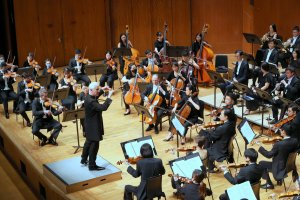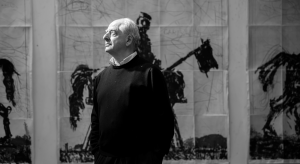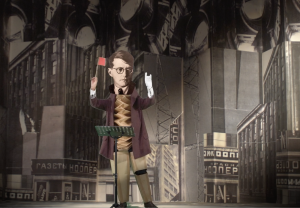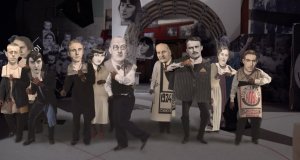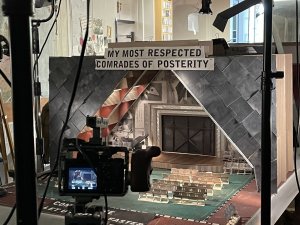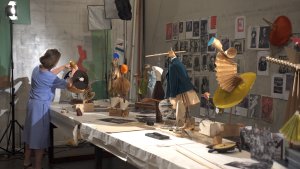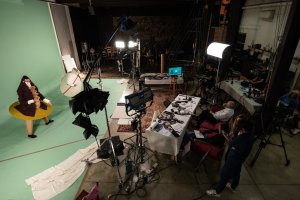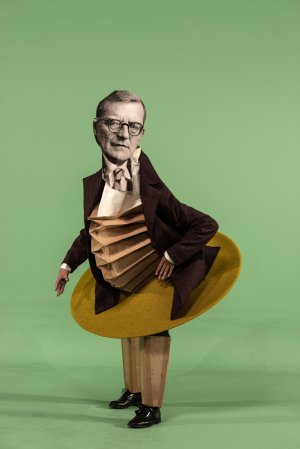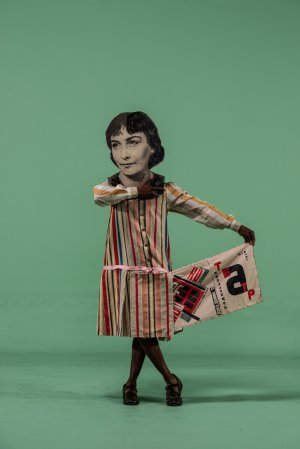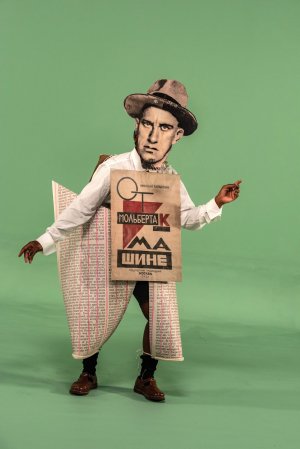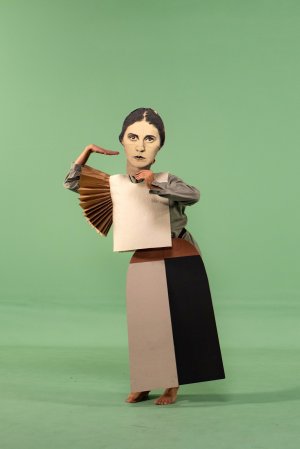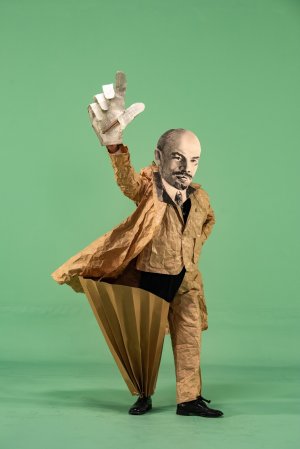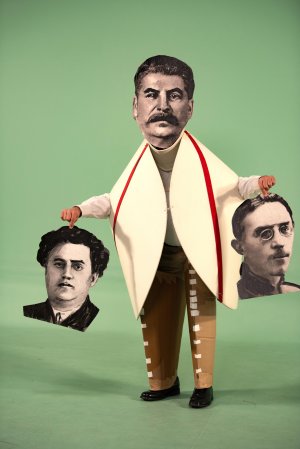For immediate release
26 Oct 2023

Presenting the closing programme of this year’s New Vision Arts Festival, Hong Kong Sinfonietta is bringing to Asia for the first time renowned South African multidisciplinary artist William Kentridge’s Oh, To Believe In Another World. Commissioned by the Luzerner Sinfonieorchester to accompany Shostakovich’s monumental Symphony No 10, the thought-provoking film illustrates the story of Shostakovich and his complicated relationship with the Soviet state from the 1920s to 1960s. With a live performance of the symphony conducted by Music Director Christoph Poppen, the audience is invited to journey through the charming set of a museum made out of cardboard, and meet various historical figures who lived in and defined one of the most complex eras in modern history.
Oh, To Believe In Another World will take place at Hong Kong City Hall Concert Hall on 18 & 19 Nov (Sat & Sun); tickets are now on sale at URBTIX.
Born in Johannesburg, South Africa in 1955, William Kentridge is internationally acclaimed for his drawings, films, theatre and opera productions. His method combines drawing, writing, film, performance, music, theatre and collaborative practices to create works of art that are grounded in politics, science, literature and history, yet maintaining a space for contradiction and uncertainty. His work has been seen in museums and galleries around the world since the 1990s, including the Museum of Modern Art in New York, Musée du Louvre in Paris, Whitechapel Gallery and Royal Academy of Arts in London, Louisiana Museum of Modern Art in Copenhagen, Kunstmuseum in Basel etc.
Whilst created for Shostakovich’s Symphony No 10, Oh, To Believe In Another World is Kentridge’s attempt to produce a visual experience that does not overwhelm the music itself and turn the symphony into film music, nor run simply as series of anodyne backdrops. It invites the audience to contemplate the trajectory that Shostakovich had to follow under immense pressure from the early days of the Soviet Union to the writing of the Symphony, which was published after Stalin’s death and regarded as one of the greatest works of the composer, with a whole world of meaning hidden between the notes.
Set inside an abandoned Soviet museum made of cardboard, the film utilises a miniature camera to bring the audience through different halls of the museum, where they meet the central characters of the story including Shostakovich and his student Elmira Nazirova, prominent poet Vladimir Mayakovsky and his socialite lover Lilya Brik, as well as Lenin, Trotsky and Stalin. The film received wide acclaim at its première by the Luzerner Sinfonieorchester in June 2022, and will see its Asian preimère delivered by Hong Kong Sinfonietta and Music Director Christoph Poppen in November 2023.
Hong Kong Sinfonietta
Oh, To Believe In Another World
18 Nov 2023 (Saturday) | 8pm
19 Nov 2023 (Sunday) | 3pm
Hong Kong City Hall Concert Hall
$450, $320, $180
(Programme duration: 1 hour without intermission)
Programme
Shostakovich – Symphony No 10 in E minor, Op 93
Music Director/Conductor: Christoph Poppen
Creative Team
Director: William Kentridge
Editors: Janus Fouché, Žana Marović, Joshua Trappler
Costume & Puppet Designer: Greta Goiris
Set & Model Designer: Sabine Theunissen
Cinematographer: Duško Marović SASC
Video Orchestrator: Kim Gunning
Executive Producer: THE OFFICE performing arts + film
- Half-price tickets available for full-time students, senior citizens, people with disabilities and their minder, and Comprehensive Social Security Assistance recipients
- 10% discount for group bookings of 4 or more standard tickets
- Suitable for 6 years old or above
- Tickets at URBTIX
- Tickets online at POPTICKET (no handling fee)
********************************************************************************
Christoph Poppen Music Director/Conductor
Conductor, soloist, chamber musician and pedagogue, Christoph Poppen has made a name for himself in diverse roles in the international musical world. As Music Director of Hong Kong Sinfonietta from the 2023/2024 season, he works closely with Music Director Emeritus Yip Wing-sie and Associate Conductor Vivian Ip on the artistic development of the orchestra, creating inspiring and innovative programmes which bring music closer to the community. Highlights of his appearances with the orchestra this season include the Hong Kong première of Toshio Hosokawa’s Violin Concerto, the Asian première of William Kentridge’s Oh, To Believe In Another World, Bach’s Christmas Oratorio with WDR Rundfunkchor Köln, his brand new Maestro’s Insights concert series, as well as the Farewell Gala of the Marvão International Music Festival in Portugal.
As Hong Kong Sinfonietta’s Principal Guest Conductor between 2015-2023, Poppen has presented to the Hong Kong audience a rich repertoire ranging from Austro-German masterpieces to contemporary works, brought the orchestra on tour to Germany and Portugal, and taken up the position of Co-chair of the Hong Kong International Conducting Competition. During the current season, he continues his close and highly successful collaboration with the Cologne Chamber Orchestra in his role as Principal Conductor, and with the Israel Chamber Orchestra as Principal Guest Conductor, while being the Artistic Director of the Marvão International Music Festival. Highlights in the 2022/2023 season included appearing with the Orquestra Sinfónica do Porto Casa da Música and return visits to the Deutsche Radio Philharmonie, Munich Chamber Orchestra and Athens State Orchestra, as well as the continuation of his recorded cycle of the complete Mozart Masses with the Cologne Chamber Orchestra for the Naxos label.
From 1995-2006, Poppen was Artistic Director of Munich Chamber Orchestra, establishing the ensemble’s new profile in a short period of time. His distinctive programmes, often contrasting classical and contemporary styles with numerous commissioned works, were highly successful. In 2006, he was appointed Music Director of Radio Symphony Orchestra Saarbrücken and from 2007-2011, he was Music Director of the newly formed Deutsche Radio Philharmonie. He has appeared with orchestras such as Vienna Symphony, Staatskapelle Dresden, Deutsches Symphonie-Orchester Berlin, Detroit Symphony, Orchestre Philharmonique de Radio France, Bamberg Symphony, Camerata Salzburg, Netherlands Philharmonic Orchestra, Residentie Orkest, Orquestra Sinfônica do Estado de São Paulo, Indianapolis Symphony, Seoul Philharmonic, New Japan Philharmonic and Singapore Symphony Orchestra. He also has a strong presence in Italy, performing regularly with the country’s leading orchestras and at festivals such as the Venice Biennale, as well as giving masterclasses. As an opera conductor, he has enjoyed acclaimed collaborations with Staatsoper Stuttgart, Oper Frankfurt, Opera Köln, Teatro Carlo Felice in Genoa, Aalto-Musiktheater in Essen and the RuhrTriennale.
Founded by Poppen in 2014, the Marvão International Music Festival has grown to become a highly successful and award-winning musical event featuring soloists such as Jörg Widmann, Augustin Hadelich, Javier Perianes and Clara-Jumi Kang. He also founded the International Academy for Music, Arts and Science in Marvão in 2019, and was the Artistic Director of the Classic Revolution Festival in Seoul, South Korea between 2020-2022, for which he curated highly inventive programmes.
As a prize-winning violinist, Poppen co-founded the Cherubini Quartet in 1978. He was appointed Professor of Violin and Chamber Music at Hochschule für Musik Detmold, and later at Hanns Eisler Hochschule für Musik in Berlin, where he was President from 1996 to 2000. From 2001 to 2005, he was Artistic Director of the renowned ARD International Music Competition. Since 2003, he has been Professor of Violin and Chamber Music at Hochschule für Musik und Theater in Munich. Since the 2021/2022 academic year, he has been Chair Professor of Violin at the prestigious Escuela Superior de Música Reina Sofía in Madrid.
*********************************************************************************
William Kentridge Director
Born in Johannesburg, South Africa in 1955, William Kentridge is internationally acclaimed for his drawings, films, theatre and opera productions. His method combines drawing, writing, film, performance, music, theatre and collaborative practices to create works of art that are grounded in politics, science, literature and history, yet maintaining a space for contradiction and uncertainty.
Kentridge’s work has been seen in museums and galleries around the world since the 1990s, including the Museum of Modern Art in New York, Albertina Museum in Vienna, Musée du Louvre in Paris, Whitechapel Gallery and Royal Academy of Arts in London, Louisiana Museum of Modern Art in Copenhagen, Museo Reina Sofia in Madrid, Kunstmuseum in Basel, Zeitz Museum of Contemporary Art Africa and Norval Foundation in Cape Town. He has participated numerous times in Documenta in Kassel (2012, 2002 & 1997) and the Venice Biennale (2015, 2013, 2005, 1999 & 1993).
Kentridge’s opera productions including Mozart’s The Magic Flute, Shostakovich’s The Nose and Alban Berg’s Lulu and Wozzeck have been seen at opera houses such as the Metropolitan Opera, La Scala in Milan, English National Opera, Opéra National de Lyon, Dutch National Opera, Sydney Opera House and at the Salzburg Festival. His theatrical productions, performed in theatres and at festivals across the globe, include Refuse the Hour, Winterreise, Paper Music, The Head & the Load, Ursonate and Waiting for the Sibyl in collaboration with the Handspring Puppet Company, Ubu and the Truth Commission, Faustus in Africa!, Il Ritorno d’Ulisse and Woyzeck on the Highveld.
In 2016, Kentridge founded the Centre for the Less Good Idea in Johannesburg – a space for responsive thinking and making through experimental, collaborative and cross-disciplinary arts practices. The Centre hosts an ongoing programme of workshops, public performances and mentorship activities.
Kentridge is the recipient of honorary doctorates from several universities including Yale University, University of London and Columbia University. In 2010, he received the Kyoto Prize. In 2012, he was awarded the Commandeur dans l’Ordre des Arts et des Lettres in France, and he presented the Charles Eliot Norton Lectures at Harvard University. In 2015, he was appointed an Honorary Academician of the Royal Academy of Arts in London. In 2017, he received the Princesa de Asturias Award for the arts, and in 2018, the Antonio Feltrinelli International Prize. In 2019, he received the Praemium Imperiale award in painting in Tokyo. In 2021, he was made a Foreign Associate Member of the Académie des Beaux-Arts in Paris. In 2022, he was presented the Order of the Star of Italy, and in 2023 in London, he received the Olivier Award for Outstanding Achievement in Opera for Sibyl.
Kentridge’s work can be found in the collections of Art Gallery of Western Australia (Perth), Art Institute of Chicago, Carnegie Museum of Art (New York), San Diego Museum of Art, Fondation Cartier, Centre Pompidou, Fondation Louis Vuitton (Paris), Los Angeles County Museum of Art, Museum of Contemporary Art, Broad Art Foundation (Los Angeles), Haus der Kunst (Munich), Sharjah Art Foundation, Mudam (Luxembourg), Musée d’Art Contemporain de Montreal, San Francisco Museum of Modern Art, Castello di Rivoli (Turin), Moderna Museet (Stockholm), Stedelijk Museum (Amsterdam), National Gallery of Victoria (Melbourne), Johannesburg Art Gallery, MAXXI (Rome), Louisiana Museum of Modern Art (Humlebaek, Denmark), National Gallery of Canada (Ottawa), National Museum of Modern Art (Kyoto), Israel Museum (Jerusalem), Inhotim (Brumadinho, Brazil), National Gallery of Australia (Canberra), Tate Modern (London), Sifang Art Museum (Nanjing), Kunsthalle Mannheim, Vehbi Koç Foundation (Istanbul), LUMA Arles, Museum of Fine Arts (Budapest), Fundació Sorigué (Lleida, Spain), Guggenheim Abu Dhabi, Kunsthalle Praha (Prague) and Amorepacific Museum of Art (Seoul); as well as private collections worldwide.
*********************************************************************************
Main characters in Oh, To Believe In Another World
Dmitri Shostakovich (1906-1975) was a Russian composer, renowned particularly for his 15 symphonies, numerous chamber works and concertos, many of them written under the pressures of government-imposed standards of Soviet art. Though his career began under a relatively free cultural climate which allowed Shostakovich to experiment with avant-garde trends, as he rose to be one of the Soviet Union’s foremost composers, he was also at times a target of criticism, denunciations and bans. He was officially denounced for a second time in 1948’s Zhdanov Decree for writing formalist music against the party’s cultural policy, and was dismissed from his teaching position at Moscow Conservatory. His Symphony No 10 was composed in 1953, the year of Stalin’s death.
Elmira Nazirova (1928-2014) was a pianist and composer who studied under Shostakovich before his dismissal from the Moscow Conservatory. There are many theories on their relationship, which appears to have been close and was documented in a series of letters Shostakovich wrote to her before the death of his first wife and second marriage. Some say that in the third movement of Symphony No 10, Shostakovich embedded motifs bearing his (D, E-flat, C, B) and Nazirova’s initials (E-A-E-D-A) that repeat and interact throughout.
Vladimir Mayakovsky (1893-1930) was a prominent poet of the Russian Revolution of 1917 and early Soviet period. He joined the Russian Social-Democratic Workers’ Party as a teenager and began writing poetry during one of his stints in solitary confinement for his political activity. A leader of the Russian Futurist movement and an avid supporter of the Bolsheviks during the Revolution, his poetry was markedly democratic, and he later lent his creative work as a spokesperson for the Communist Party. His lyrical poetry was often dedicated to his muse author Lilya Brik, with whom he had a famously public and long-term affair. He enjoyed relative freedom in its early years of the Communist Party’s power but eventually found himself disillusioned and committed suicide.
Lilya Brik (1891-1978) , Mayakovsky’s young lover, was a Russian author and socialite connected to many leading artistic figures of the Russian avant-garde. At the age of 20, she married Russian Futurist poet, editor and literary critic Osip Brik. Mayakovsky’s relationship with Lili lasted from 1917 to 1923, and afterwards he continued to have a close friendship with her and Osip, who remained the poet’s most trusted adviser and his most fervent proselytiser, and also co-founded with him the most dynamic avant-garde journal of the early Soviet era, Left Front of Art.
Vladimir Lenin (1870-1924) was a Russian communist revolutionary and head of the Bolshevik Party who rose to prominence during the Russian Revolution of 1917, one of the most explosive political events of the 20th century. The bloody upheaval marked the end of the oppressive Romanov dynasty and centuries of imperial rule in Russia. The Bolsheviks would later become the Communist Party, making Lenin leader of the Soviet Union, the world’s first communist state. His declining health in his last years led to a struggle for power within the party.
Leon Trotsky (1879-1940) was a key figure in the Bolshevik seizure of power in Russia, second only to Vladimir Lenin in the early stages of Soviet communist rule. He was undoubtedly the most brilliant intellect brought to prominence by the Russian Revolution, outdistancing Lenin and other theoreticians both in the range of his interests and in the imaginativeness of his perceptions. He was an indefatigable worker, a rousing public speaker, and a decisive administrator. On the other hand, Trotsky was not successful as a leader of men, partly because he allowed his brilliance and arrogance to antagonise the lesser lights in the communist movement. He lost out to Joseph Stalin in the power struggle that followed Lenin’s death, was thrown out of the party in 1927, and ultimately assassinated while in foreign exile.
Joseph Stalin (1878-1953) was the dictator of the Union of Soviet Socialist Republics (USSR) from 1929 to 1953, outmanoeuvering his rivals for control of the party following the death of Bolshevik leader Vladimir Lenin in 1924. He transformed the Soviet Union from a peasant society into an industrial and military superpower, but ruled by terror. Under his brutal reign, millions of his own citizens died and potential enemies were executed or sent to labour camps. Chief architect of Soviet totalitarianism and a skilled but phenomenally ruthless organiser, he destroyed the remnants of individual freedom and failed to promote individual prosperity, yet he created a mighty military-industrial complex and led the Soviet Union into the nuclear age.
Download Press ReleaseDownload Images:
Media Enquiry
Amanda Mok
Senior Marketing & Development Manager, Hong Kong Sinfonietta
Email: amanda.mok@hksinfonietta.org
Direct Line: +852 3607 2328

